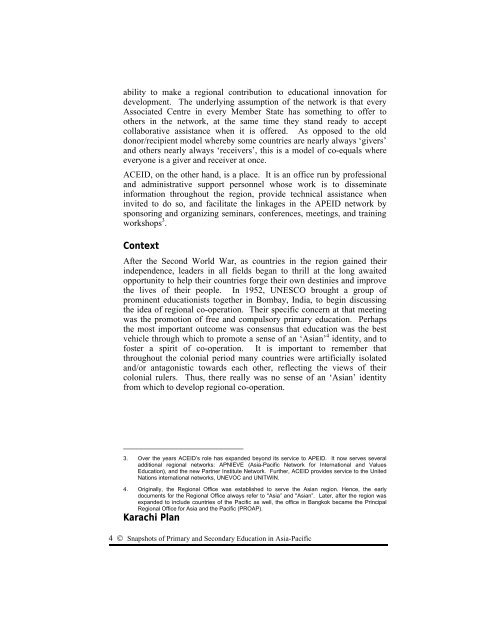Download PDF, 752KB - UNESCO Bangkok
Download PDF, 752KB - UNESCO Bangkok
Download PDF, 752KB - UNESCO Bangkok
Create successful ePaper yourself
Turn your PDF publications into a flip-book with our unique Google optimized e-Paper software.
ability to make a regional contribution to educational innovation fordevelopment. The underlying assumption of the network is that everyAssociated Centre in every Member State has something to offer toothers in the network, at the same time they stand ready to acceptcollaborative assistance when it is offered. As opposed to the olddonor/recipient model whereby some countries are nearly always ‘givers’and others nearly always ‘receivers’, this is a model of co-equals whereeveryone is a giver and receiver at once.ACEID, on the other hand, is a place. It is an office run by professionaland administrative support personnel whose work is to disseminateinformation throughout the region, provide technical assistance wheninvited to do so, and facilitate the linkages in the APEID network bysponsoring and organizing seminars, conferences, meetings, and trainingworkshops 3 .ContextAfter the Second World War, as countries in the region gained theirindependence, leaders in all fields began to thrill at the long awaitedopportunity to help their countries forge their own destinies and improvethe lives of their people. In 1952, <strong>UNESCO</strong> brought a group ofprominent educationists together in Bombay, India, to begin discussingthe idea of regional co-operation. Their specific concern at that meetingwas the promotion of free and compulsory primary education. Perhapsthe most important outcome was consensus that education was the bestvehicle through which to promote a sense of an ‘Asian’ 4 identity, and tofoster a spirit of co-operation. It is important to remember thatthroughout the colonial period many countries were artificially isolatedand/or antagonistic towards each other, reflecting the views of theircolonial rulers. Thus, there really was no sense of an ‘Asian’ identityfrom which to develop regional co-operation.___________________________3. Over the years ACEID’s role has expanded beyond its service to APEID. It now serves severaladditional regional networks: APNIEVE (Asia-Pacific Network for International and ValuesEducation), and the new Partner Institute Network. Further, ACEID provides service to the UnitedNations international networks, UNEVOC and UNITWIN.4. Originally, the Regional Office was established to serve the Asian region. Hence, the earlydocuments for the Regional Office always refer to "Asia” and "Asian”. Later, after the region wasexpanded to include countries of the Pacific as well, the office in <strong>Bangkok</strong> became the PrincipalRegional Office for Asia and the Pacific (PROAP).Karachi Plan4 © Snapshots of Primary and Secondary Education in Asia-Pacific
















